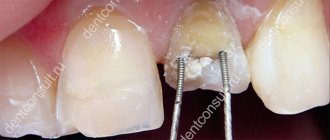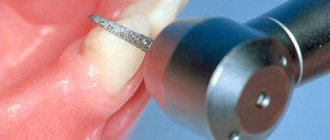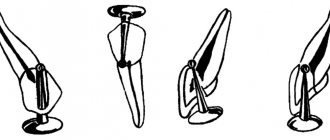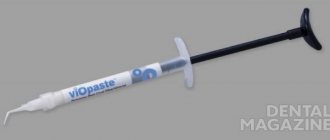Content
- Indications for stump restoration
- Formation of a tooth stump
- Dental prosthetics
- Care after crown installation
A tooth stump is a smaller version of a tooth onto which a crown is subsequently fixed. If there is enough natural tooth tissue, the stump can be easily formed using the preparation method. If there is not enough natural material, it is necessary to restore the stump under a prosthesis. There are several ways to do this.
PROMOTION
Installation of crowns, dental bridge
RUB 3,450
Pros of stump inlays
A pin inserted into a living tooth stump holds the crown well, but how long the structure will last greatly depends on the condition of the living tissues under the prosthesis. The pin serves the purpose of strengthening the ground part of the tooth; without it, it can break off. If these tissues are affected by caries or periodontitis, the living stump may become unsafe and the tooth will need to be removed.
When an artificial stump is used, the living dental organ is completely ground down, leaving only its root. The pulp is removed and the canals are filled. These tasks are carried out by a dental therapist, who then refers the patient to an orthodontist. He partially unfills the canals, attaches pins to a hole or several holes (for a multi-rooted tooth), and makes an impression of the base of the dental organ.
The impression serves as the basis for the manufacture of an orthopedic stump inlay. It must be strong in order to become a good support for the prosthesis and correspond to the physiological indicators of its future wearer. Thanks to modern materials used to make inlays, they are resistant to corrosion and destruction.
Note: The only nuance that can provoke the loss of a dental organ even with an artificial inlay installed is the inflammatory process of the base of the root in the alveolus.
This can cause suppuration in the hole and the formation of gumboil. Pain in the tooth where the inlay was installed requires an x-ray to be taken to identify possible areas of inflammation.
When is stump restoration required?
It is necessary to give the remaining tissues of the upper part of the tooth the desired shape in order to subsequently successfully secure the prosthesis - a crown or bridge. A properly shaped stump is required:
- After endodontic treatment, when tooth restoration with a filling or inlay is undesirable.
- In case of severe destruction of the crown, when restoration by other methods is impractical.
It is important to provide the crown with reliable support. In this case, the tooth root can be preserved for a long time.
Filling teeth with inlays
Sealing on the pin is performed according to the following scheme:
- Initially, the specialist diagnoses the damaged tooth using various methods. The most informative is dental radiography.
- Radiography provides comprehensive data on: the depth and shape of the canal, the location of the roots. This allows you to select the pin of the desired shape and thickness.
- Dental restoration makes no sense without a sanitation procedure. An initial examination and identification of foci of infection and carious lesions will help avoid premature destruction of the restored tooth. The doctor treats all cariogenic areas and stops foci of inflammation.
- Procedures for preparing root canals for implant installation. The specialist removes the pulp (if required), expands the canals and performs mechanical cleaning. After cleaning with the instrument, it is necessary to rinse the canals with an antiseptic solution.
- Installation of the pin with the selected fastener. A custom or factory-made pin is placed in the root canal, and the remains are removed using a specialized instrument. The canal cavity is filled with dental cement.
- After installing the pin, the specialist begins restoration of the coronal part of the tooth.
- The doctor applies the photopolymer composite layer by layer and polymerizes it with an ultraviolet lamp. This is how the size of the tooth is gradually formed.
How does the stump form?
Several methods are used depending on the situation:
- Formation of a stump without a pin. This is possible if the tooth is not severely damaged and there is enough healthy tissue to provide reliable support for the crown.
- Creation of a stump supported by a pin. In this case, the channel, which was previously tightly sealed, expands and a pin is inserted into it. The pin is fixed to durable cement and serves to hold the material and compensate for the chewing load in the future.
- Installation of the stump tab. This approach is used when there is little native tissue and creating a stump from a composite material is impractical.
What is a stump tab?
To restore a tooth affected by caries and carry out its restoration, several methods are used. The easiest way is to install a filling after careful treatment of the cavity.
Absolutely every dentist does fillings. This procedure is inexpensive. But the result does not always completely satisfy the patient. The filling may differ in color from the enamel surface, and after a while it may even darken. If filling is carried out on the front dental organs, this becomes almost a disaster, since the aesthetics of the smile suffers greatly. However, in the case of a large chip on the front incisor, it will not be possible to repair it with filling material. The filling will not hold well and will look unattractive.
For these reasons, restorative ceramic inlays are often used to restore a tooth. This procedure is more expensive than filling, but has proven itself very well in dentistry.
It is advisable to use an inlay instead of a filling if part of the tooth has broken off, or caries has affected more than sixty percent of its tissues.
The inlay is an orthopedic structure, namely a non-removable microprosthesis. A tooth restoration procedure is carried out using a stump inlay in two or three visits to an orthodontist.
Orthopedic inlays are made from the following materials:
- photosensitive composite materials;
- metals (preferably noble);
- pressed ceramics;
- metal ceramics;
- non-metallic zirconium alloys.
The use of stump inlays not only aims to restore the tissues of a separate dental organ, they can also be used to secure bridges when there is a defect. In this case, ceramic inserts play the role of locks on adjacent teeth.
The price of such products varies greatly depending on the material used. The average cost of a stump tab is 15,000 rubles. At the same time, the work of a specialist installing this microprosthesis is paid additionally in most cases.
It happens that a destroyed dental organ can no longer be saved. When the coronal part is completely missing, it will not be possible to restore it with microprosthetics. It is better to use an artificial crown in such a situation. This way the healthy root will be preserved.
In order to securely attach the crown, a base of its tissues is left on the dental organ. In case of severe tissue damage, a stump insert is used, which will perform a technological rather than a cosmetic function.
Stump inlays are made individually for each patient.
Prosthetics
When the inlay is ready, a crown can be installed on it. If we are talking about the front part of the dentition and a crown made of ceramics or zirconium dioxide, the inlay should be light. Crowns made from these materials are as close in appearance to natural teeth as possible. They also have the required level of transparency. The metal stump insert will be visible through the ceramic layer. Therefore, it is important that the support meets aesthetic requirements. A composite stump based on a pin or an intraradicular stump made of zirconium dioxide can be used.
For prosthetics of chewing teeth, strength is much more important than aesthetics. In this area, metal ceramics are often used, for which the color of the stump is not important and the main role is played by its ability to withstand loads. When the stump is ready, an impression is taken of the jaw to make a model. Based on this model, a crown is subsequently made.
From the point of view of reliability, the option with prosthetics based on a stump intraradicular inlay is considered preferable. Reinforcement with pins is considered less reliable and is associated with the risk of destruction of the restoration.
Types of dental crowns
Modern aesthetic dentistry offers a large number of materials for prosthetics; each patient will be able to choose a material according to their capabilities.
What is better: a pin or a crown on a tooth: features and differences.
Today, technology has advanced far forward, and with their help it is possible to restore a damaged or destroyed tooth and even grow a new one, much stronger and more beautiful than the previous one. There are two main procedures: installing a post or a crown. This article provides a description of the methods, their comparison and recommendations for selection.
A dental pin is a rod designed to strengthen a damaged or dilapidated tooth. The device is installed in the root zone or directly into the dentin, and a hardening mass is built up on top. The main function of the pin is to strengthen the entire tooth so that it does not break under load on the filling or the extended part.
There are two types of pins:
- Metal (titanium, brass, palladium, steel, gold (with impurities).
- Non-metallic (fiberglass, ceramics, carbon fiber).
The shape of the device is conical, cylindrical, cylindrical, screw.
According to the method of fixation, the pins are divided into:
- Active - a solid rod has a special thread with which it is screwed into the dental tissue. This type of pin is used to restore a completely or almost completely destroyed tooth, since when used, a strong load is created that can cause the tooth to split.
- Passive - the rod is fixed in the root canal using a special reinforcing material. This type is used to strengthen the tooth after treatment.
Indications for installation: half-destroyed or completely missing natural dental crown, creation of support when installing removable and fixed dentures.
Contraindications: diseases of the blood and nervous system, inflammatory pathologies of the oral cavity, caries, cysts in the oral cavity, root length is less than the planned crown height, root walls are too thin (less than 2 mm).
A crown is a dental prosthesis designed to strengthen a tooth, restore its previous shape and give an aesthetic appearance.
Crowns are not installed on the front teeth, only on the chewing ones. For the front teeth, there are veneers - thin plates made exactly to the shape of the teeth and installed on their front part.
Devices are made of ceramics (porcelain), metal, cermets, and plastics.
Crowns can be placed on a post, a damaged tooth, or an entire tooth (to give your smile a beautiful appearance and make it snow-white).
- Restoring the shape of a tooth destroyed as a result of injury, caries and other reasons.
- Restoration of chewing functions.
- Strengthening dentin.
- Whitening and improving the appearance of teeth.
Contraindications to applying a crown are age under 18 years, inflammatory diseases of the oral cavity, caries, too thin walls of the visible part of the tooth, chronic diseases in the acute stage, abnormal bite.
Restoration methods
In the case of restoring a tooth stump, the dentist can use two main methods of restoration:
- In case of minor damage to the tooth structure, with little damage to the anatomical shape, inlays are used for restoration, which help restore the tooth’s strength and shape, as well as functionality. In addition, dentists often use veneers for restoration.
- The direct restoration method is used to restore a badly damaged tooth or its complete absence. The technique involves modeling and restoration of the tooth by introducing an anchor pin into the gum, which creates the necessary support for further restoration. The material used is a composite, which has strength and the necessary shade. Most often used to restore chewing teeth.
If a tooth is completely destroyed, the dentist, in addition to the composite, can use glass ionomer, which helps enhance the effect of the composite. In addition, the material has many advantages, such as lack of toxicity, good aesthetic effect, and durability.
Pros and cons of pins
The main advantages of pins are:
- Their installation requires a small amount of dental tissue preparation.
- You can restore a tooth in just one visit to the dentist.
- Installing a pin is relatively inexpensive.
- Reliable fixation in the dental canal.
If you have a problem similar to that described in this article, be sure to contact our specialists. Don't diagnose yourself!
Why you should call us now:
- We will answer all your questions in 3 minutes
- Free consultation
- The average work experience of doctors is 12 years
- Convenient location of clinics
Single contact phone number: +7
Make an appointment
Flaws:
- The fragility of the structure - on average, a tooth with a pin restoration is destroyed in 3-4 years.
- There is insufficient adhesion between the pin rod and the crown - under heavy load, the structure may separate.
- If the size of the structure is chosen incorrectly, dental tissue can be destroyed quite quickly.
Stages of restoration
The restoration is being carried out in stages. At the same time, the dentist strictly observes the required frequency, since a violation can lead to destruction or lack of effect from the procedure.
- The preparatory stage includes anesthesia, grinding of the crown surface and expansion of the canal using filling material. The dentist also cleans the canals. The final step is thread cutting.
- Fixation of the pin using cement materials.
- Formation of the stump structure.
Dentists usually come to complete cleaning of all canals, since if the root is left, it will be subject to a large load after restoration, which causes pain.
The final stage of manipulation is grinding and polishing the structure. Therefore, the dentist evaluates the work. So, the result should be a formed stump without corrosion elements, sealed, without chips or cracks.











